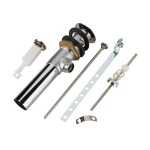Stainless Steel Gauge Chart for Sinks
When selecting a stainless steel sink for your kitchen or bathroom, understanding the different gauge options is crucial. The gauge number refers to the thickness of the metal, with lower numbers indicating thicker steel. Thicker steel is more durable, resistant to dents, and has better sound dampening qualities.
Understanding Gauge Numbers
Stainless steel gauge is measured in thousandths of an inch. For example, a 16-gauge sink is 0.0625 inches thick. The most common gauge numbers for sinks are 16, 18, and 20, with 16 being the thickest and most durable.
Benefits of Different Gauges
16-Gauge Sinks
16-gauge sinks are the most durable and highest-quality option available. They are resistant to denting, scratching, and corrosion, making them ideal for heavy-duty use. 16-gauge sinks also have excellent sound dampening capabilities, reducing noise from water flow and dishes.
18-Gauge Sinks
18-gauge sinks are a good balance of durability and affordability. They are less prone to denting than 20-gauge sinks but not as durable as 16-gauge sinks. 18-gauge sinks have moderate sound dampening capabilities and are suitable for most household uses.
20-Gauge Sinks
20-gauge sinks are the thinnest and most affordable option. They are more susceptible to denting and scratching but are still durable enough for light use. 20-gauge sinks have limited sound dampening capabilities and may be noisy in certain situations.
Factors to Consider When Choosing a Gauge
When selecting a stainless steel gauge for your sink, consider the following factors:
- Usage: If you frequently use your sink for heavy-duty tasks such as washing large pots and pans, a thicker gauge sink is recommended.
- Budget: 16-gauge sinks are more expensive than 18- and 20-gauge sinks, so consider your budget when making a decision.
- Noise Dampening: If minimizing noise is a concern, opt for a thicker gauge sink, as they have better sound dampening capabilities.
- Style: Some homeowners prefer the sleek, modern look of thinner gauge sinks, while others prefer the more traditional appearance of thicker gauge sinks. Choose the gauge that best suits your aesthetic preferences.
Additional Considerations
In addition to gauge, other factors to consider when purchasing a stainless steel sink include:
- Type of Steel: Most sinks are made from 304 stainless steel, which is resistant to corrosion and staining. 316 stainless steel is even more durable but is less common and more expensive.
- Finish: Stainless steel sinks come in various finishes, such as satin, brushed, and polished. Choose a finish that complements your kitchen or bathroom décor.
- Shape: Sinks come in a variety of shapes, including single-bowl, double-bowl, and farmhouse. Consider the size and layout of your kitchen or bathroom when selecting a shape.
By carefully considering the gauge and other factors discussed above, you can make an informed decision when choosing a stainless steel sink that meets your needs and preferences.

What Is Sink Gauge Stainless Com

Stainless Steel Sink Single Bowl 18 32 Inch

Stainless Steel Gauge Chart Astm A480 In Mm

Delta 953034 32d6 Ss Lenta 32 L Undermount 16 Gauge Stainless Steel Double Bowl Kitchen Sink With Accessories

The Ultimate Guide To Choosing A Durable Stainless Steel Kitchen Sink

33 Drop In 18 Gauge Stainless Steel 50 Double Bowl Kitchen Sink

33 In Topmount 16 Gauge Stainless Steel Single Bowl Drop Kitchen Sink With Accessories

Pergola 20 Gauge Stainless Steel 25 In Single Bowl Drop Kitchen Sink

17 Undermount 16 Gauge Stainless Steel Single Bowl Kitchen Bar Sink

Karran Profile 30 Undermount Stainless Steel Kitchen Sink With Access







